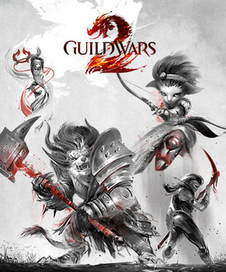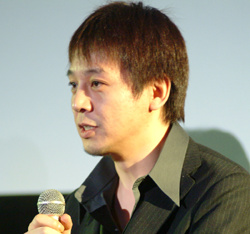
Fallout is a series of post-apocalyptic role-playing video games created by Interplay Entertainment. The series is set during the 22nd and 23rd centuries, and its atompunk retrofuturistic setting and artwork are influenced by the post-war culture of 1950s America, with its combination of hope for the promises of technology and the lurking fear of nuclear annihilation. A forerunner for Fallout is Wasteland, a 1988 game developed by Interplay Productions to which the series is regarded as a spiritual successor.
Guild Wars is a online role-playing game series developed by ArenaNet and published by NCSOFT. The games were critically well received and won many editor's choice awards, as well as awards such as Best Value, Best Massively Multiplayer Online Role-Playing Game (MMORPG), and Best Game. Guild Wars was noted for being the "first major MMO to adopt a business model not based on monthly subscription fees", its instanced approach to gameplay, and the quality of the graphics and play for computers with low specifications. In April 2009, NCSoft announced that 6 million units of games in the Guild Wars series had been sold. The sequel, Guild Wars 2, was announced in March 2007 and released on August 28 2012. It features updated graphics and gameplay mechanics, and continues the original Guild Wars tradition of no subscription fees. The Guild Wars series had sold 11.5 million copies by August 2015.

Istaria: Chronicles of the Gifted is a massively multiplayer online role-playing game (MMORPG) developed by American studio Virtrium and originally released by Artifact Entertainment as Horizons: Empire of Istaria. Tulga Games, LLC acquired the game and all related assets on January 25, 2005 and sold them to EI Interactive July 2006. On July 18, 2007, Virtrium LLC (Vi) acquired the rights to the game.
A tank is a style of character in gaming, often associated with a character class. A common convention in real-time strategy games, role-playing games, fighting games, multiplayer online battle arenas and MUDs, tanks redirect enemy attacks or attention toward themselves in order to protect other characters or units. Since this role often requires them to suffer large amounts of damage, they rely on large amounts of vitality or armor, healing by other party members, evasiveness and misdirection, or self regeneration.

Dungeons & Dragons Online (DDO) is a massively multiplayer online role-playing game (MMORPG) developed by Turbine for Microsoft Windows and OS X. The game was originally marketed as Dungeons & Dragons Online: Stormreach, then renamed Dungeons & Dragons Online: Eberron Unlimited upon switching to a hybrid free to play model, and was finally rebranded Dungeons & Dragons Online, with the introduction of Forgotten Realms-related content. Turbine developed DDO as an online adaptation of Dungeons & Dragons (D&D), based loosely on the D&D 3.5 rule set. The game is set on the unexplored continent of Xen'drik within the Eberron campaign setting, and in the Kingdom of Cormyr within the Forgotten Realms campaign setting.

Guild Wars Nightfall is a fantasy action role-playing game and the third stand-alone campaign in the Guild Wars series developed by ArenaNet, a subsidiary of NCSOFT corporation. Nightfall was released worldwide on October 27, 2006 after beginning in development in November 2005.
The music of the Final Fantasy Tactics series, composed of Final Fantasy Tactics, Final Fantasy Tactics Advance, Final Fantasy Tactics A2: Grimoire of the Rift, and Final Fantasy Tactics: The War of the Lions, was primarily composed by Hitoshi Sakimoto. He was assisted by Masaharu Iwata in composing the music for Final Fantasy Tactics. The Final Fantasy Tactics Original Soundtrack, a compilation of almost all of the music in the game, was released by DigiCube in 1997, and re-released by Square Enix in 2006. No separate soundtrack has been released for Final Fantasy Tactics: The War of the Lions. The soundtrack was well received by critics, who found it to be astounding and one of the best video game music soundtracks in existence at the time of its release.

Sangokushi Online (三國志Online) is Koei's third online Romance of the Three Kingdoms game developed for Microsoft Windows platform. Koei announced the development of its latest MMORPG in mid-2006. Koei planned on releasing Sangokushi Online in Japan in the first quarter of 2007 followed by the rest of Asia. However Koei started the first pre-open testing on September 27, 2007. A second pre-open testing was begun on February 7, 2008. Additionally, these plans do not reference a possible North American or European release. This follows Koei's tradition of Asia-only MMO releases, such as Nobunaga's Ambition. The game ended as servers shut down on 19 July 2010.

Guild Wars 2 is a massively multiplayer online role-playing game developed by ArenaNet and published by NCSOFT. Set in the fantasy world of Tyria, the game follows the re-emergence of Destiny's Edge, a disbanded guild dedicated to fighting the Elder Dragons, a Lovecraftian species that has seized control of Tyria in the time since the original Guild Wars. The game takes place in a persistent world with a story that progresses in instanced environments.

Star Wars: The Old Republic is a massively multiplayer online role-playing game (MMORPG) based in the Star Wars universe. Developed by BioWare Austin and a supplemental team at BioWare Edmonton, the game was announced on October 21, 2008. The video game was released for the Microsoft Windows platform on December 20, 2011 in North America and part of Europe. Early access to the game began one week before release, on December 13, 2011, for those who had pre-ordered the game online; access opened in "waves" based on pre-order date.

Flyff is a fantasy MMORPG by Korean development company Gala Lab.

Dragon Nest is a free-to-play fantasy MMORPG developed by Eyedentity and currently available in different regions and languages. Aside from boasting a non-targeting combat and skill system within instance dungeons, Dragon Nest also revolves around a rich story which is told in different points of view depending on the player's chosen class. Dragon Nest receives new content, balance patches and cash shop items on a monthly basis. Major expansions that include several new dungeons, Nests, new classes, multiple new features or remake of old ones, extensive class adjustments and a raise on the level cap take place every year.
Masaharu Iwata is a Japanese video game composer. After graduating from high school, where his musical projects included composing on a synthesizer and playing in a cover band, he joined Bothtec as a composer. He composed the soundtrack to several games there, beginning with 1987's Bakusou Buggy Ippatsu Yarou, and after the company was merged into Quest, he left to become a freelance composer. His most well-known projects include Ogre Battle, Tactics Ogre, Final Fantasy Tactics, and Final Fantasy XII, though throughout his career he has composed music for over 65 games. He is one of the founding members of Basiscape, headed by fellow composer Hitoshi Sakimoto and currently one of the largest independent Japanese video game music production companies. His compositions for strategy role-playing games such as the Ogre Battle and Final Fantasy Tactics series have been described as "among the most well-recognized in the genre".
Pocket Legends is an iOS and Android mobile 3D MMO developed by Spacetime Studios. It has variously been described as the first cross-platform, mobile 3D MMO. Since 2012, no new expansions are released as the player base has shrunk due to the company's focus on the launch of new titles.

World of Warships is a free-to-play naval warfare-themed massively multiplayer online game produced by international game developer and publisher Wargaming after releasing the first military-oriented F2P MMO World of Tanks. Besides random battles against others, player can play cooperative battle types against bots or an advanced PvE battle mode called Scenario battles. For the most skilled players, two seasonal competitive modes are available – Ranked and Clan battles. The game was released for Microsoft Windows on September 17, 2015 and later for Steam and Microsoft Store on November 15, 2017.

Age of Wushu is a free-to-play 3D martial arts action MMORPG, developed by Chinese company Snail. The game revolves around the Wuxia-inspired lore surrounding martial arts and adventures in Ming Dynasty China. The European version, Age of Wulin, which had been published by Webzen, closed in July 2017, with players being given the option of transferring to a new European server established as part of Age of Wushu, the version of the game published by Snail USA.

Armored Warfare is a free-to-play vehicular combat video game developed by Mail.ru and published by My.com for Microsoft Windows, PlayStation 4 and Xbox One. The game features combat vehicles from the 1950s through modern day and includes destructible environments as well as player vs. environment and player vs. player gameplay. The game was originally in development by Obsidian Entertainment, who worked on the game until being dropped in 2017.

Echo of Soul is a massively multiplayer online role-playing game developed by Korean game developer Nvius and published in North America and Europe by Aeria Games.
Star Conflict is a free-to-play dynamic MMO space action game. The gaming platform Steam describes it as an "action-packed, massively multiplayer space simulation game". The core of the game is PvP spaceships battles, PvE (Co-Op) missions and an open world. The game uses a free-to-play business model.




















